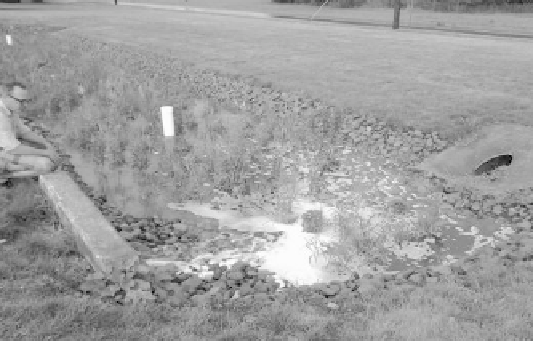Environmental Engineering Reference
In-Depth Information
FIGURE 33.2
At NSF Study Site 2, an Osorb stormwater system is estimated to treat approximately 6.5M gal/year of industrial
stormwater runoff. Note: The foaming is associated with trace surfactants and industrial agents historically
used at this site, including halons from chemical ires in 1974 and twice in the 1980s. The water has also picked
up contaminants from parking lots and loading docks. This image was taken during a heavy rainfall event
shortly after system was constructed in July 2012.
communities. These healthy communities result in extremely vigorous plant life
and substantial and unpredicted reductions in nutrient loading associated with
algae blooms and other water quality issues. This effect was not observed in the
column laboratory testing conducted from 2009 to 2011.
3. Osorb nanomaterials are extremely durable and continue to perform with no deg-
radation of performance in stormwater systems measured to date. Accelerated
laboratory testing indicates 12-20+ year durability should be seen in the ield.
4. These systems are passive and require no power, and they are thus extremely
cost-effective. The price-per-gallon treatment of stormwater from these systems is
presently $0.0008/gal to $0.0013/gal over the projected life span of the system. This
is <50% of any comparable treatment system capable of this volume and quality of
stormwater management.
5. Commercially interested parties, including civil engineers, Leadership in Energy
and Environmental Design (LEED) architects, campus planners, and stormwater
management agencies, are particularly excited to ind a system this effective at
treating stormwater; however, many of them simply cite the extreme healthiness
of the plants in the system as the primary reason for interest. Many of them have
moved away from other “green” stormwater systems because the urban runoff
regularly kills off the plants in the system. Osorb captures the same pollutants
and in turn chemically reacts with them, reducing them to foods accessible to the
plantings, as will be discussed below.
33.4 Stormwater Industry
The runoff control industry is driven by civil engineering irms that have a very long his-
tory with the subject, and regulations set by federal, state, and local agencies. Until today,


